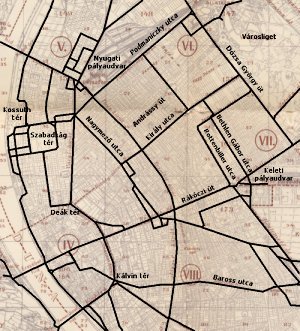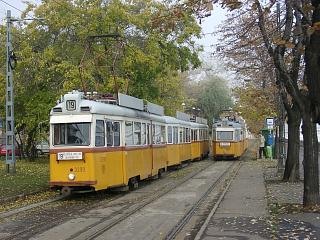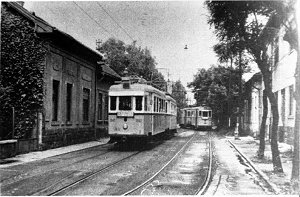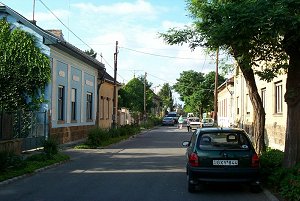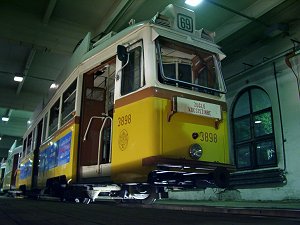Trams of Hungary and much more...
|
Last updated: 4. March 2017 - I have no time to update this website anymore :(
It was hard for me to come up with a name for this website: I like public transportation in general, but my favorites are trams. Especially Budapest trams. On the other hand you'll find other transportation means here, just like trams of other places, too, so the title "Trams of Budapest" might be deceiving...
Click here if you're not interested in historic bits, just the pictures!
History of the tram in Budapest
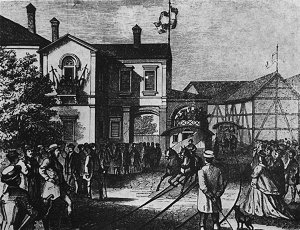

To the left: the first horse tram (1866), to the right: the first
electrified tram (1887)
The first horse tram service in Budapest was launched in 1866: the trains were doing the Kálvin tér-Újpest route, which is still one of the most heavily used traffic routes, only that we now have a subway ("metro" as we call it) instead of trams on the surface. After the success of the first line new routes were launched in great numbers, but there was one great problem: Buda and Pest were two seperate cities back then, so they've had two companies operating two separate networks: BKVT in Buda and PKVT in Pest. There was no connection between the networks. The twin cities have united in 1873 and so did the companies too, although only a few years later. The new company name was the old one: BKVT. (If you're wondering why I'm tiring you with this: the name of the old companies will occur on these pages several times!)
In 1887 a new star was born: in November, a narrow-gauge electric tram service was launched on the Grand Boulevard between the Nyugati railway station and Király utca. It was a pilot project designed and financed by Siemens et Halske, who have just invented the tram a few years ago. The trains used an under-surface current collector that was specifically designed for Budapest. The line was a big success so Siemens have founded a new public transport company called BVV, which begot BVVV a few years later when Siemens sold its interests. In 1889, the continent's first normal-gauge tram service was launched, and the old horse tram company BKVT soon begun to electrificate it's own routes to keep up. This decision marked the start of a race between BKVT and BVVV: the companies were soon struggling to top each other at all costs. On the map to the right you can see all streets and places in the inner city of Budapest where trams ran between 1914 and 1981 - quite a dense network, I would say (of course not by US scale) - and most of this was built by these two companies until 1923, when they were united!
After World War 1 things looked
pretty bad: only a fragment of the public transport system was usable,
and after two political revolutions, the shareholders of BKVT and BVVV
refused to take their companies back. Thus a new company called BSZKRT
(spell "bhaz-cart") was formed in 1923. In the first few years rolling
stock, rail and eletric systems were unified and/or rebuilt, but right
after that they also began to experiment.  "Experimenting"
meant evaluating new techniques (twin-set coupling, auxiliary-power
multiple units, articulated cars) and restructuring the whole public
transport system of Budapest. Beside other things this also meant that
most of the tram routes in the narrow streets of the inner city were
closed.
"Experimenting"
meant evaluating new techniques (twin-set coupling, auxiliary-power
multiple units, articulated cars) and restructuring the whole public
transport system of Budapest. Beside other things this also meant that
most of the tram routes in the narrow streets of the inner city were
closed.
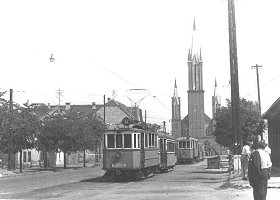 After
the second World War, things looked even more catastrophic: massive
loss on human life and other resources, all bridges over the river Danube
(which seperates the city in two halves: Buda and Pest) were destroyed,
there was no eletricity, etc... yet the first tram route in Pest was
re-started while there were still bitter fights going on on the other
side of theDanube! In 1950 a new company was formed in full state ownership
and control: FVV (for "Capital Tramway Company"). This company was only
responsible for the trams and trolleybuses, but not for buses, suburban
railways and ferryboats. They did a good job: old vehicles (many of
which were made well before World War I) were renovated, and new types
were introduced (for example the "UV class",
which is a kind of a symbol for Budapest trams). Much of what is still
in use (including infrastructure and rolling stock) was bought or built
in this era. Of course there were also unpleasant changes: the tram
network was simplified - some of the "classic" routes have dissappeared.
After
the second World War, things looked even more catastrophic: massive
loss on human life and other resources, all bridges over the river Danube
(which seperates the city in two halves: Buda and Pest) were destroyed,
there was no eletricity, etc... yet the first tram route in Pest was
re-started while there were still bitter fights going on on the other
side of theDanube! In 1950 a new company was formed in full state ownership
and control: FVV (for "Capital Tramway Company"). This company was only
responsible for the trams and trolleybuses, but not for buses, suburban
railways and ferryboats. They did a good job: old vehicles (many of
which were made well before World War I) were renovated, and new types
were introduced (for example the "UV class",
which is a kind of a symbol for Budapest trams). Much of what is still
in use (including infrastructure and rolling stock) was bought or built
in this era. Of course there were also unpleasant changes: the tram
network was simplified - some of the "classic" routes have dissappeared.
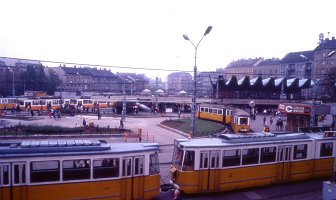 In
1968 all public transportation means (trams, trolleybuses, buses, light
rail commuter trains, the Széchenyi hegy rack railway, ferryboats, and
after 1972 the subway, too) were united into one company: BKV. Financially
this might have been a good decision, but on the other hand the city
council in that time was into just two things: new underground lines
and buses, and the new company haven't done anything against this. Because
of this, trams were neglected, while buses or trolleybuses became the
official way to go. By this time most of the rolling stock was terrifyingly
old (manufactured between 1896 and 1939), and the construction works
for the underground overloaded both the city and BKV financially, so
there was no possibility for other big developements like buying large
series of new trams or launching new routes. In connection with the
replacement of tram routes with the subway we call this the "demise"
of the Budapest tram network. Since the opening of the last section
of the M3 (the third metro line) in 1990, there are only minor developments
- but big cutbacks. Routes were and are shortened or rarified year for
year, and some of the plans suggest that the future of the tram is not
very bright...
In
1968 all public transportation means (trams, trolleybuses, buses, light
rail commuter trains, the Széchenyi hegy rack railway, ferryboats, and
after 1972 the subway, too) were united into one company: BKV. Financially
this might have been a good decision, but on the other hand the city
council in that time was into just two things: new underground lines
and buses, and the new company haven't done anything against this. Because
of this, trams were neglected, while buses or trolleybuses became the
official way to go. By this time most of the rolling stock was terrifyingly
old (manufactured between 1896 and 1939), and the construction works
for the underground overloaded both the city and BKV financially, so
there was no possibility for other big developements like buying large
series of new trams or launching new routes. In connection with the
replacement of tram routes with the subway we call this the "demise"
of the Budapest tram network. Since the opening of the last section
of the M3 (the third metro line) in 1990, there are only minor developments
- but big cutbacks. Routes were and are shortened or rarified year for
year, and some of the plans suggest that the future of the tram is not
very bright...
The sad tendencies I mentioned in connection with the dusk of the Budapest tram can be seen in other cities of Hungary, too. Debrecen, Miskolc, Nyíregyháza, Pécs, Szeged and Szombathely also used to have trams. Sadly only Debrecen, Miskolc and Szeged were able to save their tram system (the first two only have one distinct route!). In Debrecen there are plans for building another line, but that's still not much in contrast to the original six lines...
Click here if you're not interested in even more historic bits, just the pictures!
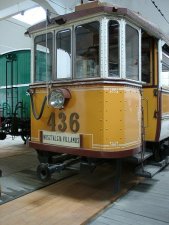 At
the end of the 19th century hungarian trams looked very much like all
the trams around the world, but then a disctinct "hungarian" look started
to appear, which was most dominant on the front of the cars. One of
the most typical examples, a vintage BVVV streetcar
can be seen to the left. This design features a front windshield divided
into three parts with sharp corners and with the middle one beeing small
and openable, narrow steps up to the open platform, where the tram driver
stands, and sinkable side windows.
At
the end of the 19th century hungarian trams looked very much like all
the trams around the world, but then a disctinct "hungarian" look started
to appear, which was most dominant on the front of the cars. One of
the most typical examples, a vintage BVVV streetcar
can be seen to the left. This design features a front windshield divided
into three parts with sharp corners and with the middle one beeing small
and openable, narrow steps up to the open platform, where the tram driver
stands, and sinkable side windows.
The transport companies designed the cars, and then different companies manufactured them. The most important names of the heydays were Schlick-Nicholson and Ganz. Earlier the electric parts were bought from Siemens or General Electric Union and the transport companies installed them into the chassis' themselves, but then even that duty was taken over by Ganz. By the 30's the company has became the ultimate tram manufacturer in Hungary, and it kept that position until the late 70's.
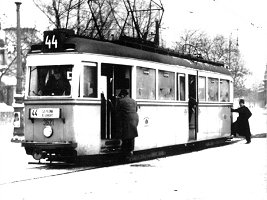 One
of their most ambitious designs was the 3600-series
(see picture to the right), also called "Stukas" after the german dive
bomber aircraft (the sound of the vehicle was similar). This was a
simple, but fast, comfortable and relatively low-floor streetcar, designed
in 1939 midst pre-war conditions, when the governement has commited
itself for supporting other transportation means than cars. Later they
expanded the idea of this streetcar to build long multiple sets: the
new train set was introduced in 1948 but due to technical difficulties
the idea of producing it in great quantities was dismissed. A few years
later the need for new trams with a greater capacity was even greater,
so Ganz designed the UV-class, which was the
most dominant vehicle type in the Budapest tram system until the mid-90's.
One
of their most ambitious designs was the 3600-series
(see picture to the right), also called "Stukas" after the german dive
bomber aircraft (the sound of the vehicle was similar). This was a
simple, but fast, comfortable and relatively low-floor streetcar, designed
in 1939 midst pre-war conditions, when the governement has commited
itself for supporting other transportation means than cars. Later they
expanded the idea of this streetcar to build long multiple sets: the
new train set was introduced in 1948 but due to technical difficulties
the idea of producing it in great quantities was dismissed. A few years
later the need for new trams with a greater capacity was even greater,
so Ganz designed the UV-class, which was the
most dominant vehicle type in the Budapest tram system until the mid-90's. 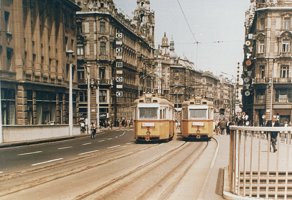 Optically
these new cars were very much like the old Stukas, but the electrical
system and the 2-axle boogies were totally different. 375 cars were
built until 1965, when Ganz introduced its 8-axle
articulated tram. Although this latter design was less reliable,
they still play an important role in the city's life, especially on
route 4 and 6 (Great Boulevard). Thirty cars from the series were modernised
in the late 90's with Ansaldo choppers, but now there are plans to replace
the italian control system with a hungarian design using a more modern
IGBT techology.
Optically
these new cars were very much like the old Stukas, but the electrical
system and the 2-axle boogies were totally different. 375 cars were
built until 1965, when Ganz introduced its 8-axle
articulated tram. Although this latter design was less reliable,
they still play an important role in the city's life, especially on
route 4 and 6 (Great Boulevard). Thirty cars from the series were modernised
in the late 90's with Ansaldo choppers, but now there are plans to replace
the italian control system with a hungarian design using a more modern
IGBT techology.
 Between
1980 and 84 BKV bought 322 4-axle Tatra
T5C5 cars. These were the first non-hungarian trams in Budapest
in almost hundred years! They were purposed as a temporary replacement
for ancient 2-axle cars (some of which was manufactured in 1896 - this
gives you a hint how old they were), but the financial situation of
the country was so bad at the time that the idea of purchasing more
modern trams was dismissed - of course this led to the demise of some
really interesting tram routes!
Between
1980 and 84 BKV bought 322 4-axle Tatra
T5C5 cars. These were the first non-hungarian trams in Budapest
in almost hundred years! They were purposed as a temporary replacement
for ancient 2-axle cars (some of which was manufactured in 1896 - this
gives you a hint how old they were), but the financial situation of
the country was so bad at the time that the idea of purchasing more
modern trams was dismissed - of course this led to the demise of some
really interesting tram routes!
The next streetcar type to be bought by BKV was the DÜWAG TW6000 from Hannover, Germany. The purchase of these used trams (76 pieces) was almost hindered by political struggles in the city council, but they're now here and are having a great impact on the public transport system because they give a chance for the tram to survive in a quite anti-tram situation.
As for vehicles of the other tram network systems of Hungary: between the seconn World War and the nineties they mostly used used vehicles (that were dumped in Budapest, like the "home-made" articulated car, which can still be seen in these cities), but now they're on their own: Miskolc has bought used 8-axle Tatra KT8D5's from Slovakia and 6-axle E1's from Vienna, while Szeged purchased brand new 4-axle T6A2's. Debrecen chose a hungarian design and bought ten new 6-axle Ganz trams. All these new or almost new acquisitions are still not enough: the cities are looking for a replacement for the old "home-made" articulated. There were even rumours of Debrecen buying a few TW6000's from Hannover but this was never confirmed.
Click here if you're not interested in anything but the pictures!
I don't work for transport companies, nor do I have the qualifications to pretend I know as much about these things as a transportation engineer. Trams are just one of my hobbies - I take photos of them and read much about them, but I'm not a professional. Please tell me when you know something in a different way!

Crown jewels of Budapest: our trams
As for my photos: what started out as "by-product" has became one of my main hobbies. Originally I only wanted to make a webpage about my childhood transportation memories, with a few old pictures borrowed from fellow tram maniacs. Then I thought about taking a couple of photos of what was then to be seen on the Budapest rails. The next thing I remember was that I was spending a considerable part of my salary on the developing of film negatives. Then I bought a digital camera and things became easier. My photos appeared in magazines, such as LRTA's Tramways&Urban Transit (where a three-page essay about the past and future of Budapest trams, written by me, was also published), VDVA's Blickpunkt Strassenbahn (among others cover photo of 2/2004), the hungarian magazine Indóház, the austrian periodical tramway&modell and Transit Australia. Also, one of my favorite "hobby in a hobby"-type shots, namely a night shot was selected as the European Railway Picture Gallery's picture of the Month in March, 2004. I'm glad that so many people like my photos - it's a nice thing!
This website is made in my free time - I do it for fun. I would probably update it more often if I had more time, but I have to earn my living, too :) If you liked my pages and you feel like it, I would be most honoured if you bought me something off my amazon.co.uk Wish List! Or if you live in the US, from my amazon.com Wish List!
One of my most ambitious projects is a series about the "lost" tram routes of Budapest. It started out as a free-time occupation but turned into a kind of historic dissertation. Originally I just looked up a few old photos and took photographs of the same place in the present, but then then the material (facts, dates and figures) got bigger and bigger.
Unfortunately you won't find this material here because of one simple reason: it's in hungarian and it would take too much time to translate it to english. So, what will you find here, then?
Pictures. Pictures of the past and pictures of the present. Still-lifes taken in tramsheds (we call them remises), and scenes of current events. Detail photographs of the vehicles, and pictures of unusual situations. I hope that you'll have a great time browsing my pages!
Bah, take me to the picture pages!
I'm always on the lookout for tram pictures of Budapest. If you happen to have some and you're into sharing, please e-mail me! I know there are tram fans out there who have been to Budapest earlier and took pictures. These pictures are valuable for me (not in the financial way - unfortunately I don't have the money to pay for old pictures) because they show our trams in a different way than we - hungarian tram maniacs - see them, and because they are usually of better quality than those taken by hungarian enthusiasts. This has got a simple explanation: before 1990 Hungary was locked behind the "Iron Curtain", so the film material (slide or negative) and the photo labs available to the average tram-maniac were not really up to high standards. Of course there are exceptions, but the average photographer was unable to acquire the same equipment as any "western" tram fan was able to! It's always a feast for me to look at some old pictures taken by people coming from the other side of the "Iron Curtain"!
Please, share your old Budapest tram pictures with me! Thanks in advance!
...
Tram-hiker's guide to Budapest
The unofficial guide to Budapest trams!
Last update: March 20, 2016
The trams of my
childhood
Treasures from the bottom of the drawer: transit tickets and passes
Moments in
the tram life of Budapest
The introduction of
the TW6000 to Budapest in 2001
Tram-fans from Germany
visiting Budapest, 13.08.2001
The way to the
tram driver contest, 04.04.2002
Flooding of the Danube,
August, 2002
Budapest tram
snapshots - October, November, December 2003
Budapest tram
snapshots - Summer and Autumn of 2004
Budapest tram
snapshots - from December 2004 to April 2005
Budapest tram snapshots - Summer of 2005
Budapest tram snapshots - August/September 2005
Budapest tram snapshots - September/October 2005
Budapest tram snapshots - October/November 2005
Going snowblind in December 2005
The arrival of the longest tramcar in the world
The first test run of the Combino Supra in the city
Flood of the Danube I-II.
A visit to the new home of the world's longest tramcars
Anniversary of a true classic - the UV is 50 years old!
Some more Combino Budapest
Budapest tram snapshots - March/April/May 2005
Combino-Initiatation in Budapest, 1.7.2006.
Good-bye-party for the UVs in South-Pest
Budapest tram snapshots May-August 2006 I-II
Budapest tram snapshots September-October 2006 I-II-III
Leave-taking of the UVs of route 19 I-II
Short movies and photos of UVs on route 41's outer end
Midnight run - on more than 2 kilometers of Combino trams!
Leave-taking of the UVs of route 41
Good-bye to UVs on route 47 - and in the whole of Budapest!
Budapest tram snapshots - early 2008
Trams and winter 2009-10
Budapest - public transit events in the first half of 2010
Budapest public transit life - Spring to Winter 2012 I-II. (02-MAR-2013)
Budapest public transit life - Spring to Winter 2012 III-IV. (12-MAR-2013)
Other hungarian
cities with trams
Szeged, 26.08.2000
Debrecen, 27.10.2001
Miskolc, 2001
Szeged, 10.03.2002
Ex-Viennese E1
tramcars in Miskolc, 12.15.2002
Lost routes of
Miskolc, and a few "tram by night" pictures
Chartered ride
in snowy Szeged
"Open Day" in Szeged
A visit to Debrecen
"New" Tatras and heritage streetcars in Szeged I-II.
Autumn visit to Szeged I-II.
A city with a lost tramway: Pécs
"Open gates day" in Szeged I-II.
Miskolc: about trams and closed factories
Szeged in winter's sleep, December 2009
Cold hours in Miskolc, January 2011
Szeged: new tram here, new line starting soon (20-FEB-2012)
Miskolc: before the tram extension went into use (27-FEB-2012)
Szeged: knee-deep in snow (25-APR-2012)
New line, new trams - plus visits to the tram and the trolley bus depot (04-JUN-2012)
Close-up
UV motorcars - current rolling
stock, with pictures
The Urban Public Transport
Museum at Szentendre
The Urban Public Transport
Museum, continued
Budapest Urban
Public Transport Museum at Szentendre, again - but this time
with proper pictures
The central tram/metro
workshop of the BKV, Budapest
The Milleneum Subway
Line: heritage still in use
Short videos
Aesthetic anatomy
of the UV streetcar I.
Aesthetic anatomy
of the UV streetcar II.
A visit to the depot
of the Budapest cogwheel railway
Hungarian steel-frame
trams and the "Füzesi Árpád" tram workshop
An introduction to the Transport Museum in Budapest
An introduction to the "Kisföldalatti"
The Urban Public Transit Museum in Szentendre, celebrating its 20th anniversary in 2012 (22-NOV-2012)
Lost rails: closed
tram routes in Budapest
Route 8, closed on
31. December, 1980
Route 58, closed on
17. January, 1977
Trams on Erzsébet
híd (Elisabeth bridge)
Route 43, closed on
1. December, 1983
Route 15, closed on
15. November, 1977
Route 65, closed on
13. January, 1980
115 years
of electric tramways - Nyugati pályaudvar
Route 25, supplemented
by bus from 1. November, 1972, closed in 1973
Route 64, supplemented by trolley bus since 3.1.1980.
More to life
than Hungary...
Trams of Vienna, Austria
Vienna trams by night
Trams of Prague,
the Czech Republic I-III.
Trams of Sarajevo, Bosnia
Trams of Graz, Austria
Trams of Milan, Italy
Trams of Blackpool,
England I-II.
Croydon Tramlink,
England
Docklands Right Railway
- London, England
Trams of Cologne, Germany
I-III.
Trams of Antwerp,
Belgium
Trams of Munich,
Germany
Vienna trams
in the rain I-III.
A visit to the
central tram/subway/bus workshop of Wiener Linien, Vienna I-II.
Tramwaytag
2003, Vienna I-II.
Linz,
Gmunden, Innsbruck - trams, trains and cable cars I-IV.
Tour de Trams: Munich,
Augsburg, Ulm
Tour de Trams:
Stuttgart I-II.
Tour de Trams:
Heilbronn, Heidelberg
Tour de Trams:
Mannheim, Ludwigshafen I-II.
Tour de Trams:
Kassel
Tour de Trams:
Essen, Oberhausen, Mülheim I-II.
Tour de Trams:
Düsseldorf and Cologne
100 years of
Wiener Linien - tram parade in Vienna I-II.
Trams of Amsterdam,
The Netherlands I-III.
Trams of Bern, Switzerland
Trams of Basel, Switzerland
I-II.
Trams of Zürich,
Switzerland I-II.
Trams of Transylvania:
Arad, Cluj-Napoca, Oradea I-II.
Trams of Innsbruck,
Austria
Trams of Graz, Austria
Tour de Trams: Mannheim,
Heidelberg, Ludwigshafen
Tour de Trams: Frankfurt/Main,
Erfurt
Tour de Trams: Nordhausen,
Magdeburg, Berlin, Woltersdorf
Tour de Trams: Potsdam,
Dortmund, Krefeld
Tour de Trams: Düsseldorf
Tour de Trams: Köln
and Bonn
Tour de Trams: Linz
A short visit to Kosice
(SK)
Through Slovakia
with an old railcoach (May 2003)
Potsdam: 125 years
of trams I-II.
Berlin: a tale of
two cities I-II.
Vienna: nice
trams in bad weather
Tramwaytag
2005 + miscellaneous from Vienna
Tour de Trams light:
Trams of Bremen I-II.
Tour de Trams
light: the Hannover Tram Museum in Wehmingen I-III.
Tour de Trams
light: Hannover - from tram to Stadtbahn
Tour de Trams light:
a few minutes in Munich
Trams of Zagreb,
Croatia I-III.
Wandering around
in Vienna again
To Switzerland via Linz
and Innsbruck
Zürich again...
Basel, tramspotter
paradise
Trams of Geneva
Lausanne, Montreux,
Bern
Innsbruck in snow
Vienna, February
2006.
Tram-parade
in Amsterdam I-II.
A sweep through The
Hague
Farewell-party for
the DÜWAGs of Cologne
Trams of Brno, Czech
Republic
Vienna Tram
Day 2006
Innsbruck, August
2007
Trams of Upper
Silesia
Brno trams in the morning, in the
afternoon, and in the night I-II.
Upper-Silesian trams in September 2008, I-V.
Amsterdam's tram museums back in 2003
Good-bye to Dresden's Tatra trams
December 8, 2007 - the last day of Stuttgart's last classic tram line
Dresden's trams in May 2010
Stuttgart's tram museum in Zuffenhausen, December 2007
The trams of Warsaw in April 2008
Warsaw celebrating 100 years of electric trams (April 2008)
Trams of Ghent/Gent (Belgium)
Trams of Brussels, September 2010
A bit of the Berlin U-Bahn
A bit of the Berlin U-Bahn, part 2
Trams and trains of Berlin, November 2010
Cottbus, a city of "extended Tatras" (21-JAN-2012)
Potsdam: old trams, new trams (01-FEB-2012)
Trams of Berlin, September 2011 (06-FEB-2012)
Vienna in Autumn 2011 (26-APR-2012)
Trams of Prague in March 2012 (18-MAY-2012)
Trams of Ostrava in September 2012 (11-APR-2013)
Halle (Saale): Meandering in the Rain (13-APR-2013)
Trains and Co.
Central European
Steam Engine Grand Prix
The Children's Railway of Budapest
The Day of the Budapest Children's Railway, 2010
I started to translate my original (hungarian) site to english quite lately, and I don't think I'll ever have the time to translate every single page, so the material available here is limited. But at least I tried to pick out the best parts of it for you :-)
Second, some of the pictures shown here are not mine. They are displayed upon kind permission of their photographer, owner, copyright holder or representative. However, you might find some photos of unknown origin and/or unauthorized usage - if you see something like this or suspect any kind of copyright violation, please notify me!
As for my own photos: you can use them if you ask for permssion via e-mail :-)
I would also like to express my thankfulness to the following people: Tim Boric, Stephen Dee, Leroy W. Demery Jr., Balázs Dénes, Heinz Heider, Jakob Kindby Holm, Matyi Kónya, Nagy Zsolt Levente, Németh Zoltán Ádám ("NZA"), Németh Zoltán Gábor ("division by zero"), Lars F. Richter, Michael Russell, Harald Schachenhofer, Sujbert László, Szántó Ferenc, Szigeti Dániel, Mike Taplin, "Mr. Cyber", and others.
Home
of the hungarian trams - Villamos.Budapest.hu
PublicTransport.Net:
trams and other transportation means from all Europe
Another hobby of mine:
General
aviation in Hungary (in english)

